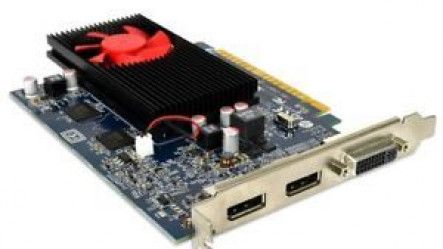AMD Radeon R7 M265 video card review: Test | Specs | CPU | Config – Not wanting to lag behind the rebranding masters from the “green” camp, AMD has announced a new discrete video accelerator Radeon R7 M265. Just like its predecessor Radeon HD 8750M, this video accelerator is based on the 28nm Mars GCN chip, it has 384 shader cores, 24 TMUs and 8 ROP units. The graphics can run at up to 825 MHz and have access to 2GB DDR3 RAM with 128-bit bandwidth and 2000 MHz.
The Radeon R7 M265 graphics card can compete with the GeForce GT 645M in terms of performance, so demanding and modern games like Metro: Last Light will be played in low resolution and low to medium details. Less demanding games like Dead Space 3 can be played freely at 1600×900 pixels and high graphics settings.
Supported technologies
you PowerTune – a calculator that calculates the power consumption of the card in real time at intervals of milliseconds based on the analysis of the task being performed (without any analog sensors). And if possible, the GPU clock speed increases. Note that this is not a reset of the frequency relative to the nominal when the power threshold is reached, but, on the contrary, a precisely verified dynamic acceleration.
ATI PowerPlay Is a dynamic power management technology used in some graphics processing units (GPUs) manufactured by AMD (formerly ATI). The principle of operation is based on tracking the GPU load, determining the optimal parameters and correspondingly changing the clock frequency of the chip, memory and supply voltage, thereby optimizing the power consumption and heat dissipation of the video card. The technology in idle modes can disable unused GPU blocks.
ATI Eyefinity — a technology developed by the American company AMD that allows multiple displays to be connected together to a personal computer. ATI Eyefinity assumes connection from one to six displays inclusive to one graphics card. Desktop duplication and stretching modes are supported across multiple monitors, and a special new feature allows displays to be grouped into one large screen that can display a PC desktop or, for example, video, as well as windowed or full-screen 3D applications.
AMD HD3D — The technology is supported by an extended and open ecosystem that, when combined with specific AMD hardware and software technologies, enables the 3D viewing of many applications and processes on the PC.
AMD Enduro — Automatically disables AMD Radeon discrete graphics for lightweight applications and extends battery life.
AMD Zero Core — In a deep idle state, the new GPU consumes less than 5% of the power of full-fledged mode, disabling most of the functional blocks in this mode.
Specifications
| AMD Radeon R7 M265 | ||
| Manufacturer | ||
| AMD | ||
| Series | ||
| R7 200 | ||
| Architecture | ||
| GCN | ||
| Streams | ||
| shraders 384 | ||
| Core clock speed | ||
| 725-825 MHz | ||
| Memory frequency | ||
| 2000 MHz | ||
| Memory bus width | ||
| 128 pages | ||
| Memory type | ||
| DDR3 | ||
| Memory Amount | ||
| 2048 MB | ||
| DirectX | ||
| DirectX 11.1, Shader 5.1 | ||
| Technology | ||
| 28 n.m. |
Synthetic tests
- 3DMark (2011) – Performance GPU: 1902
- 3DMark (2013) – Fire Strike Standard Graphics: 1313
Game test results for mobile video cards may vary depending on laptop model and configuration
Game testing
The Elder Scrolls V: Skyrim. At medium settings (1366×768, Medium, 4xAA), the average number of FPS in the game was 38. At high graphics settings (1366×768, High 8xAA, 8xAF) – 28 PS. When the display resolution was increased to 1920 × 1080 pixels, and the graphics settings were increased to the level (Ultra, 8xAA, 16xAF}, the average FPS level dropped to 16.
AMD Radeon R7 M265:Medium,(1366×768)—38%
AMD Radeon R7 M265:High, (1366×768)—28%
AMD Radeon R7 M265: Ultra,(1920×1080)—16%
Intel Iris Pro Graphics 5200:High, (1366×768)—21%
Metro Last Light. At low settings (1024 x 768, Low, DX10, 4AF) the average number of FPS in the game was 33. At medium graphics settings (1366 x 768, Medium, DX11, 16AF) – 22FPS. When the graphics settings were increased to the level (High, DX11, 16xAF}, the average FPS level dropped to 16. At the maximum graphics settings and a resolution of 1920×1080 pixels, the average number of frames per second was 9.
BioShock Infinite. At medium settings (1366×768, Medium, AF, AA), the average number of FPS in the game was 42. At high graphics settings (1366×768, High, AA, AF) – 35 FPS. When the graphics settings were increased to the (Ultra, DOF) level, and the resolution was up to 1920 x 1080 pixels, the average FPS level dropped to 12.
AMD Radeon R7 M265: Medium,(1366×768)—42%
AMD Radeon R7 M265:High, (1366×768)—35%
AMD Radeon R7 M265: Ultra,(1920×1080)—12%
Intel Iris Pro Graphics 5200:High, (1366×768)—35%
Tomb Raider. The resolution is 1366×768 pixels, the graphics settings in the game (Normal, FXAA 4xAF), the average FPS was 45. When the resolution was increased to 1366×768 pixels, the graphics settings in the game (High, FXAA 8xAF) averaged 30 FPS. level (Ultra, FXAA 16xAF), and resolutions up to 1920 × 1080 pixels, the average FPS level dropped to 15.
AMD Radeon R7 M265: Medium,(1366×768)—45%
AMD Radeon R7 M265:High, (1366×768)—30%
AMD Radeon R7 M265: Ultra,(1920×1080)—15%
Intel Iris Pro Graphics 5200:High, (1366×768)—35%















